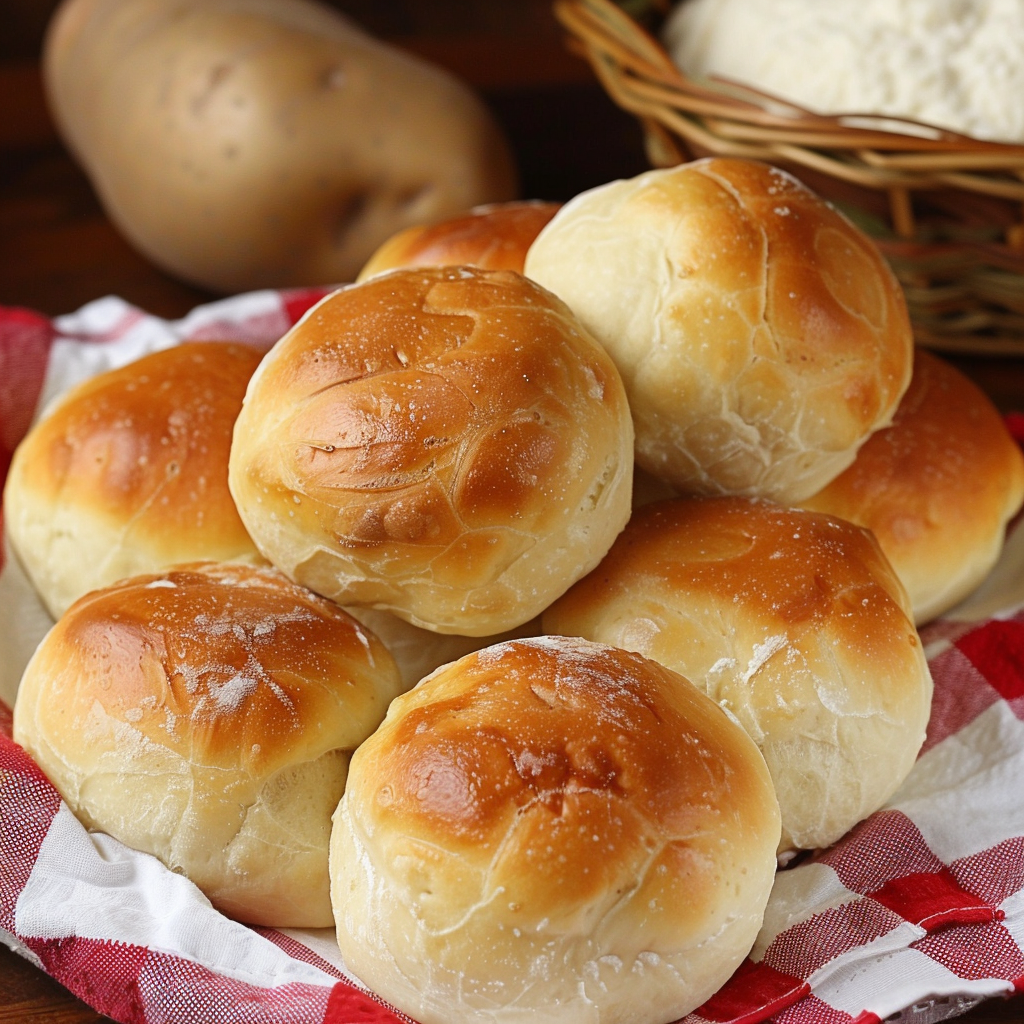Soft Potato Buns Recipe – Fluffy, Tender, and Easy to Make

Share
Soft Potato Buns are Fluffy and Tender
Homemade captures an essence of love and caring. There’s something so satisfying about making homemade buns. It’s not just the process, which is surprisingly easy, but also the joy of sharing these fresh, fluffy buns with family and friends. When you set a warm, soft potato bun on the table, the smiles are inevitable. There's nothing quite like the smell of bread baking in the oven, and the thrill of pulling out a batch of perfectly golden buns is a feeling that never gets old. Homemade buns make any meal feel special, and when your loved ones take that first bite, you’ll know it was all worth it. These soft potato buns are especially tender and fluffy, making them a fantastic addition to any dinner spread.
Did You Know?
Potato buns have been a beloved staple in baking for many years, especially in American cuisine. The addition of mashed potatoes and potato water to the dough not only imparts a unique flavor but also contributes to the buns' moist and tender texture. Potatoes are naturally gluten-free, which helps to break down the gluten in the flour, resulting in a softer bun. This makes potato buns an excellent choice for those who enjoy a light and airy bread.
Yield: 12 Buns
Ingredients:
1 large russet potato, peeled and cubed
1/2 cup potato cooking water, reserved
2 1/4 teaspoons active dry yeast
1/2 cup warm milk
1/4 cup unsalted butter, melted
1/4 cup granulated sugar
1 large egg
1 teaspoon salt
3 1/2 cups all-purpose flour
Instructions:
Cook Potato: Boil potato until soft, then mash. Reserve 1/2 cup cooking water.
Personal Tip: Make sure to mash the potato as smoothly as possible to avoid lumps in the dough.
Yeast Mixture: Mix reserved water and warm milk. Add yeast, let sit until frothy.
Personal Tip: Be sure the liquid is warm, not hot, to avoid killing the yeast.
Combine: Mix potato, butter, sugar, egg, and salt. Add yeast mixture.
Personal Tip: Mix thoroughly so the ingredients are well incorporated.
Add Flour: Gradually add flour, knead until smooth.
Personal Tip: Knead until the dough is soft and elastic, about 10 minutes by hand.
First Rise: Let rise 1-1.5 hours until doubled.
Personal Tip: Place the dough in a warm spot to encourage faster rising.
Shape Buns: Divide into 12 pieces, shape into balls, place on a baking sheet.
Personal Tip: Try to shape the buns evenly so they bake uniformly.
Second Rise: Let rise 30-45 minutes until puffy.
Personal Tip: Cover the buns with a damp cloth to keep them moist as they rise.
Bake: Preheat oven to 375°F. Bake 15-20 minutes until golden.
Personal Tip: Rotate the baking sheet halfway through for even browning.
Nutritional Information (Per Bun): Calories, 170, Protein, 4g, Carbohydrates, 30g, Fiber, 1g, Net Carbohydrates, 29g, Fat, 4g, Saturated Fat, 2g, Cholesterol, 25mg, Sodium, 170mg, Sugars, 4g, Glycemic Index, Medium
Kitchen Tips, Great Ideas, How to Save Money:
- Choosing Potatoes: Use russet potatoes for the best texture. They are starchy and mash well, contributing to the soft and fluffy texture of the buns.
- Yeast Activation: Ensure the milk and reserved potato water are warm (110°F) to properly activate the yeast. This helps the dough rise better and results in fluffier buns.
- Kneading Dough: Knead the dough until it is smooth and elastic. This helps develop the gluten, which gives the buns their structure and softness. If kneading by hand, this process should take about 10 minutes.
- Make Ahead: Prepare the dough the night before and let it rise overnight in the refrigerator. In the morning, bring the dough to room temperature before shaping and baking. This is perfect for fresh buns without the morning rush.
- Storing Leftovers: Store leftover buns in an airtight container at room temperature for up to 2 days. For longer storage, keep them in the refrigerator or freeze for up to 3 months. Thaw and reheat as needed.
- Serving Suggestions: These buns are perfect for burgers, sandwiches, or as a side with butter. They can also be used for breakfast sandwiches or served with soup.
- Cost-Saving Tips: Buy potatoes in bulk to save money. Store them in a cool, dark place to keep them fresh longer. Using store-brand ingredients can also reduce costs without compromising quality.
- Enhancing Flavor: Brush the tops of the buns with melted butter before baking for a richer flavor and a golden crust. You can also sprinkle sesame seeds or poppy seeds on top for added texture and flavor.
- Baking Evenly: Rotate the baking sheet halfway through the baking time to ensure even cooking and a uniformly golden crust.
- Gluten-Free Option: Substitute the all-purpose flour with a gluten-free flour blend. Ensure the yeast and other ingredients are also gluten-free for those with gluten sensitivities.
Let’s Learn About Different Varieties of Potatoes and What They Are Best Used For
Potatoes come in many different varieties, each offering a unique texture and flavor. For example, russet potatoes are the best choice for baking and mashing due to their starchy texture, which allows them to become fluffy and light when cooked. Yukon Gold potatoes, on the other hand, are waxier and are perfect for roasting or making creamy mashed potatoes. Fingerling potatoes are small, with a thin skin and a buttery flavor, making them ideal for salads or roasting. Red potatoes hold their shape well when cooked, making them great for soups or potato salads. Knowing which potato to choose can greatly enhance your recipe, so experimenting with different types will help you discover new ways to enjoy them.


